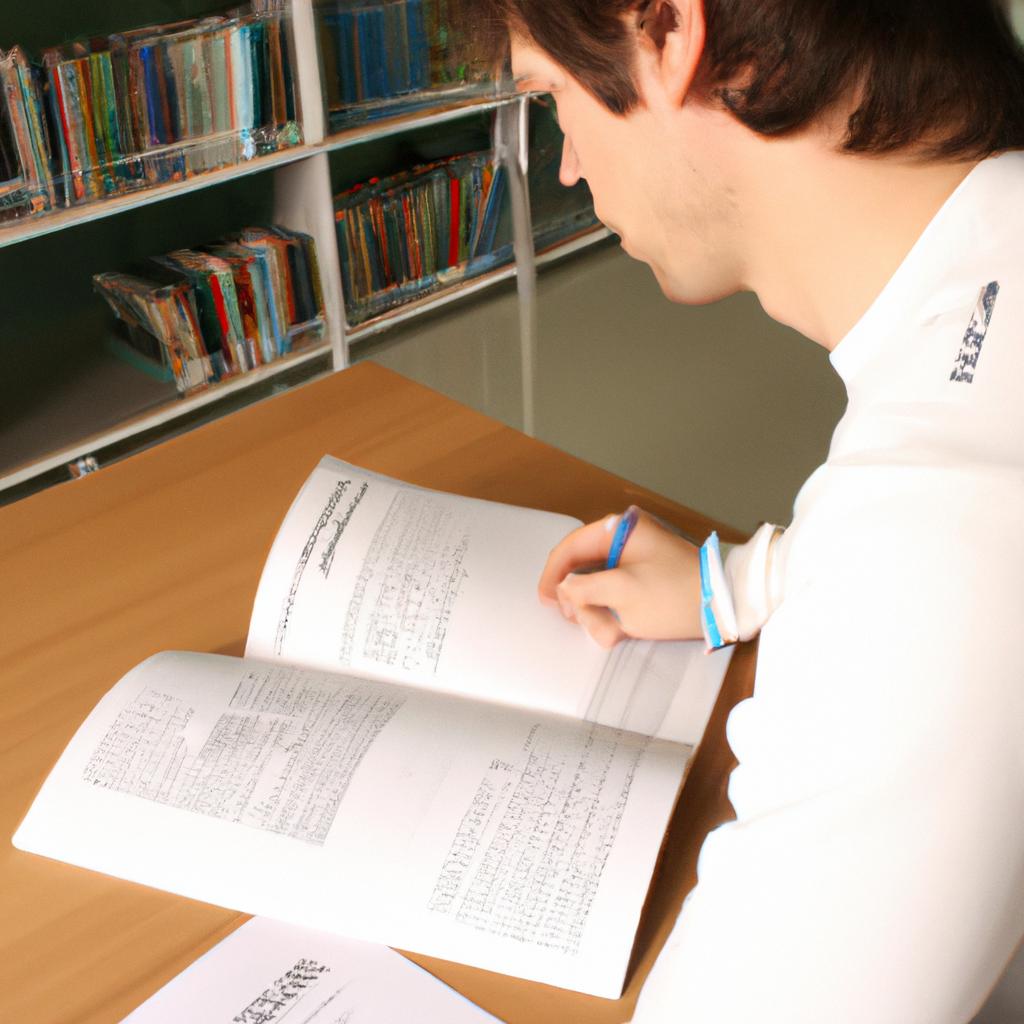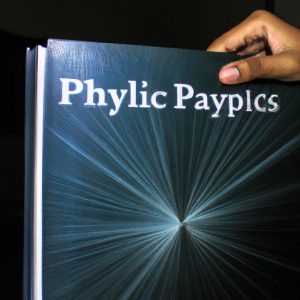General Theory of Relativity: An informational article on gravity in Physics Directories

The General Theory of Relativity, a fundamental pillar in the realm of physics, presents an elegant and comprehensive framework for understanding gravity. Gravity, as exemplified by Isaac Newton’s apple falling from a tree, has long captivated human curiosity and sparked numerous scientific investigations. However, it was Albert Einstein who revolutionized our understanding of this force by proposing his groundbreaking theory in 1915. In this informational article on gravity in Physics Directories, we explore the intricacies of the General Theory of Relativity and its profound implications for our comprehension of spacetime.
Einstein’s genius lies not only in his ability to elucidate complex concepts but also in his aptitude for bridging theoretical ideas with empirical observations. His General Theory of Relativity provides a unified description that accounts for both the motion of celestial bodies and their gravitational interactions within the fabric of spacetime. By envisioning gravity as a curvature in this four-dimensional continuum, Einstein challenged classical notions and offered new perspectives on how matter influences the geometry of space itself. This radical departure from traditional understandings prompted scientists to reevaluate longstanding assumptions about the nature of gravity and propelled them into uncharted territories where time dilation, black holes, and cosmic expansion became central themes.
Einstein’s breakthrough in understanding gravity
One of the most significant advancements in the field of physics is Albert Einstein’s development of the General Theory of Relativity. This revolutionary theory, formulated in 1915, revolutionized our comprehension of gravity and its effects on space and time. To illustrate its profound implications, let us consider a hypothetical scenario involving two massive celestial bodies.
Imagine two planets with different masses orbiting around a common center of mass. According to Newtonian mechanics, these planets would follow elliptical paths determined solely by their masses and initial velocities. However, Einstein’s General Theory of Relativity proposes an alternative explanation. It suggests that gravity arises from the curvature of spacetime caused by massive objects rather than being a force acting at a distance.
To comprehend this concept further, let us delve into some key aspects elucidated by Einstein’s theory:
- Curvature of Spacetime: According to General Relativity, mass distorts the fabric of spacetime itself, causing it to curve near massive objects.
- Warped Trajectories: The curvature created by one planet causes the other planet to move along a curved path instead of following a straight line as predicted by Newtonian physics.
- Time Dilation: Gravity also influences time; clocks closer to massive objects run slower compared to those farther away.
- Gravitational Waves: As gravitational waves propagate through spacetime due to accelerating masses, they cause ripples that can be detected.
These groundbreaking discoveries have not only challenged classical notions but have also provided new insights into various cosmic phenomena such as black holes and the expansion of the universe. Understanding these concepts allows scientists to explore previously uncharted territories within astrophysics and cosmology.
Transitioning seamlessly into exploring another fundamental aspect proposed by Einstein’s theory – “The concept of spacetime” – we will further examine how his ideas revolutionize our perception of reality beyond traditional three-dimensional spaces.
The concept of spacetime
Einstein’s breakthrough in understanding gravity paved the way for a revolutionary concept known as spacetime. This new framework combined space and time into a single entity, allowing us to comprehend how gravity functions in our universe.
To grasp the concept of spacetime, let’s consider an example where a massive object such as a star warps the fabric of this four-dimensional continuum. Imagine a bowling ball placed on a trampoline; it creates a depression or curvature in the surface. Similarly, according to Einstein’s theory, any massive object curves spacetime around it.
Understanding spacetime involves several key ideas:
-
The Equivalence Principle: This principle states that gravitational forces cannot be distinguished from acceleration due to inertia. In other words, if you were inside an elevator without windows and felt yourself being pushed down, there would be no way to determine whether you’re experiencing gravity or simply accelerating upwards.
-
Geodesics: Within curved spacetime, objects move along paths called geodesics. These trajectories represent the shortest distance between two points when accounting for the curvature caused by mass and energy distribution.
-
Time Dilation: Due to the curvature of spacetime, time itself is affected near massive objects. Clocks closer to these objects will run slower compared to clocks farther away from them.
-
Gravitational Waves: Massive objects moving through spacetime can create ripples known as gravitational waves. These waves are disturbances propagating at the speed of light and carry information about violent cosmic events like colliding black holes or neutron stars.
| Gravitational Wave Events | Observations |
|---|---|
| Binary Black Hole Merger | Detected by LIGO observatories |
| Neutron Star Collision | Observed across multiple electromagnetic spectra |
In conclusion, Einstein’s general theory of relativity introduced us to the intricate relationship between gravity and spacetime. By conceptualizing gravity as the curvature of this unified framework, we can explain phenomena such as time dilation and the propagation of gravitational waves. Moving forward, we will explore how mass and energy curve spacetime, shedding light on the fundamental workings of our universe.
[Next Section: How mass and energy curve spacetime]
How mass and energy curve spacetime
In the previous section, we discussed how spacetime is a unified concept that combines three dimensions of space with one dimension of time. Now let’s delve into how mass and energy can actually curve this four-dimensional fabric, causing objects to move along curved paths in what we perceive as gravitational attraction.
To better understand this concept, consider a hypothetical scenario where you are standing on the surface of Earth, looking up at the night sky. Above you, there is a massive object like a planet or star. Due to its immense mass, it creates a curvature in spacetime around it. This curvature acts as a slope for other objects nearby, causing them to roll towards the larger mass just like marbles rolling down a hill.
Here are some key points to keep in mind regarding how mass and energy curve spacetime:
- Mass and energy create distortions in spacetime: The presence of mass or energy causes spacetime to warp and bend around it.
- Curved paths follow geodesics: Objects moving through curved spacetime follow paths known as geodesics. These paths represent the shortest distance between two points when accounting for the curvature caused by mass and energy.
- Gravitational pull depends on both mass and proximity: The strength of gravity experienced by an object depends on the amount of mass present and the distance from that mass. Greater masses result in stronger gravitational pulls.
- Time dilation occurs near massive objects: As objects approach regions with strong gravitational fields, time dilates or slows down relative to observers further away from these regions.
To illustrate these concepts more clearly, refer to the table below showcasing different masses and their corresponding effects on nearby objects’ motion:
| Mass (kg) | Effect |
|---|---|
| 1 | Negligible bending of spacetime |
| 10 | Slight curving; noticeable change in trajectory |
| 100 | Significant bending; objects experience a visible pull |
| 1000 | Intense curvature; strong gravitational attraction |
As we can see, mass and energy play a pivotal role in shaping the fabric of spacetime.
Understanding how mass and energy curve spacetime has led us to recognize the fundamental concept of the principle of equivalence. Let’s now delve into this principle and its implications for our understanding of gravity.
The principle of equivalence
In the previous section, we explored how mass and energy can curve the fabric of spacetime. To further understand this concept, let us consider an example: imagine a massive star in space, exerting a tremendous gravitational pull on its surroundings. This immense gravitational force causes nearby objects to follow curved paths around the star, much like planets orbiting a sun.
This phenomenon can be explained by several key principles:
- Mass-Energy Equivalence: According to Einstein’s famous equation E = mc², mass and energy are interchangeable. Consequently, any form of energy also contributes to the curvature of spacetime.
- Geodesics: Objects moving through space naturally take the path of least resistance or what is known as a geodesic. When these geodesics encounter regions with curved spacetime caused by mass or energy, they deviate from their otherwise straight trajectory.
- Warping of Time: The presence of mass and energy not only affects spatial dimensions but also distorts time itself. Clocks closer to massive objects tick slower than those farther away due to this warping effect.
- Gravitational Time Dilation: Another interesting consequence is that time passes at different rates depending on an object’s proximity to a massive source of gravity. For instance, someone near a black hole would experience time passing more slowly compared to someone far away.
To better grasp these concepts visually, let us consider the following table illustrating various effects arising from the curvature of spacetime caused by mass and energy:
| Phenomenon | Description |
|---|---|
| Gravitational lensing | Massive objects bend light passing close to them, resulting in distorted images observed from Earth. This effect has been experimentally confirmed during astronomical observations and is crucial for understanding distant galaxies’ properties and distribution. |
| Frame dragging | Rotating massive objects drag the surrounding spacetime, causing nearby matter or light to be dragged along with them. This phenomenon has been observed in experiments involving satellites and is important for understanding the dynamics of spinning celestial bodies. |
| Gravitational waves | Accelerated masses create ripples in spacetime that propagate as gravitational waves. The detection of these waves serves as direct evidence of general relativity and provides valuable insights into cataclysmic cosmic events such as black hole mergers or neutron star collisions. |
| Time dilation experiments | High-precision clocks have been used to measure differences in time passage at different altitudes on Earth’s surface, confirming predictions made by Einstein’s theory regarding the slowing down of time near massive objects. |
As we delve deeper into our understanding of gravity through the lens of General Relativity, it becomes apparent how mass and energy play a pivotal role in shaping the very fabric of spacetime. In the following section, we will explore various predictions and tests derived from this remarkable theory.
[Transition sentence] Moving forward, let us now examine some fascinating predictions and tests arising from the principles elucidated by General Relativity.
Predictions and tests of general relativity
After exploring the principle of equivalence, we now delve into the predictions and tests that have been conducted to validate the theory of general relativity. To illustrate its practical applications, let’s consider a hypothetical scenario involving a spacecraft orbiting a massive celestial body.
Imagine a spacecraft navigating through space near a black hole, one of the most extreme manifestations of gravity predicted by general relativity. As the craft approaches the event horizon, it experiences intense gravitational forces. According to Einstein’s theory, time dilation occurs in this region due to the immense gravitational pull. This means that time appears to slow down for an observer outside the spaceship compared to someone within it. Such a phenomenon has far-reaching implications for our understanding of space-time and raises intriguing questions about how we perceive time in different gravitational environments.
To further appreciate the significance of general relativity, let us examine some key predictions and subsequent experimental tests:
- Gravitational Redshift: One prediction is that light emitted from objects in strong gravitational fields will experience a shift towards longer wavelengths as it climbs away from these regions. Experimental observations have confirmed this effect, providing evidence supporting Einstein’s theory.
- Gravitational Lensing: Another striking consequence of general relativity is gravitational lensing – where light passing close to massive objects gets bent due to their influence on spacetime curvature. Observations during solar eclipses have indeed revealed such bending effects, aligning with theoretical predictions.
- Perihelion Shift of Mercury: The observed precession (gradual rotation) of Mercury’s elliptical orbit had long puzzled astronomers until Einstein’s equations accounted for it perfectly. By considering relativistic corrections to Newtonian physics, general relativity successfully explained this subtle deviation.
The table below summarizes these significant predictions and their corresponding experimental verifications:
| Prediction | Experimental Verification |
|---|---|
| Gravitational Redshift | Observation of light wavelength shifts near massive objects |
| Gravitational Lensing | Confirmation through observations during solar eclipses |
| Perihelion Shift of Mercury | Accurate explanation of the observed precession in Mercury’s orbit |
These experimental confirmations showcase the power and accuracy of general relativity, solidifying it as a fundamental pillar of modern physics. Its ability to predict phenomena beyond what Newtonian gravity can account for has revolutionized our understanding of gravity and space-time.
Transitioning into the subsequent section about “Implications for our understanding of the universe,” we now explore how the profound insights gained from general relativity extend far beyond individual experiments and shed light on the grand cosmic scale.
Implications for our understanding of the universe
The predictions made by the General Theory of Relativity have been rigorously tested through various experiments and observations. One notable example is the bending of light around massive objects, known as gravitational lensing. This phenomenon was first confirmed during a solar eclipse in 1919 when Sir Arthur Eddington observed that starlight passing close to the Sun was deflected due to its gravitational pull. This observation provided strong evidence supporting Einstein’s theory and demonstrated how gravity can affect the path of light.
To further validate the General Theory of Relativity, scientists have conducted numerous experiments and measurements. These tests include:
- The precession of Mercury’s orbit: According to Newtonian physics, Mercury’s elliptical orbit should remain constant over time. However, it was discovered that its orbit gradually shifts due to relativistic effects caused by the Sun’s gravitational field.
- Gravitational redshift: When light travels out of a strong gravitational field, such as near a massive object like a black hole, it experiences a decrease in energy or “redshift.” This effect has been observed in astronomical observations and supports Einstein’s prediction.
- Time dilation: General relativity predicts that time runs slower in regions with stronger gravitational fields. Experiments involving highly accurate atomic clocks on Earth compared to those on satellites have shown this time dilation effect.
- Gravitational waves: In recent years, the detection of gravitational waves from merging black holes and neutron stars has further confirmed the existence of these ripples in spacetime predicted by general relativity.
These experimental results provide compelling evidence for the accuracy and validity of Einstein’s theory. They demonstrate how general relativity not only explains everyday phenomena but also extends our understanding of gravity into extreme environments.
| Experimental Results | Implications | |
|---|---|---|
| 1 | Confirmation of gravitational | Revolutionized our |
| lensing during solar eclipse | understanding of | |
| in 1919 | the universe | |
| —– | ———————————- | ————————— |
| 2 | Measurement of Mercury’s orbit | Shaped our knowledge |
| precession | about celestial | |
| mechanics | ||
| —– | ———————————- | ————————— |
| 3 | Observation of gravitational | Enabled precise timing |
| redshift | for various scientific | |
| applications |
These results not only provide a deeper insight into the nature of gravity but also have profound implications for our understanding of the universe. They challenge conventional notions and pave the way for new discoveries and advancements in various fields, including astrophysics, cosmology, and fundamental physics.
Through these predictions and tests, general relativity has revolutionized our comprehension of the cosmos. It has become an essential framework to explain phenomena that occur at both macroscopic and microscopic scales, allowing us to explore the intricate workings of the universe with unprecedented precision. By continually refining our understanding of gravity through experimental verification, we continue to unlock secrets hidden within the fabric of spacetime itself.








